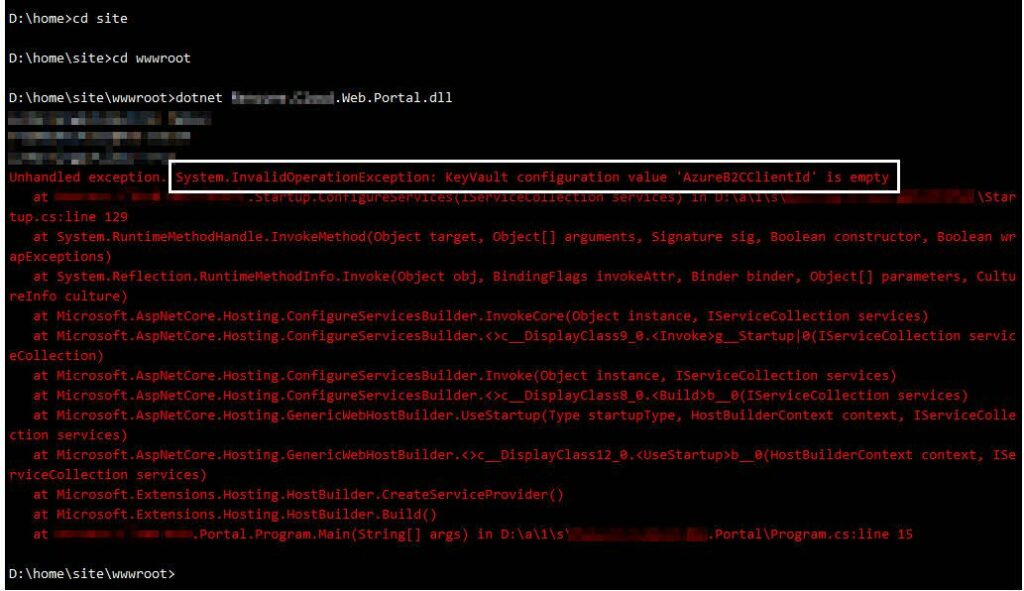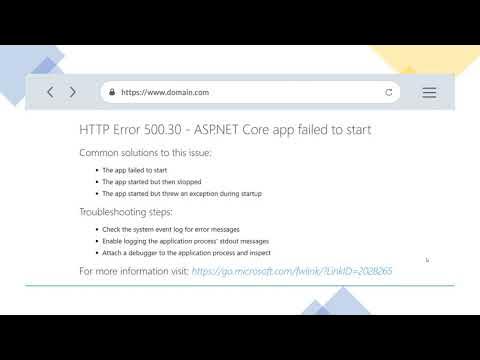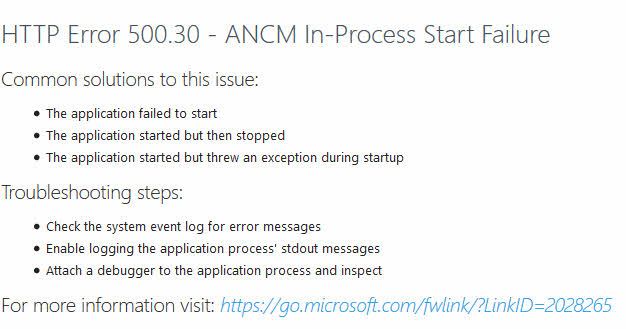An unexpected error like the “HTTP Error 500.30 – ASP.NET Core app failed to start” can be a major obstacle to progress. Despite its daunting nature, this error is not insurmountable and can be addressed through a systematic approach and a touch of patience.
While the error message is vague and numerous factors may contribute to it, equipped with the appropriate knowledge and troubleshooting techniques, a resolution can be achieved efficiently.
HTTP Error 500.30 – ASP.NET Core app failed to start!
The “HTTP Error 500.30 – ASP.NET Core app failed to start” is a prevalent error message indicating a failure in the proper initiation of an ASP.NET Core application.
This error implies that the application encountered an unexpected issue, hindering its ability to fulfill the request.
A comprehensive understanding of the “HTTP Error 500.30 – ASP.NET Core app failed to start” is essential for effective troubleshooting.
It assists in identifying the specific cause of the problem, facilitating a prompt and efficient discovery of the most suitable solution.
We recommend gaining in-depth knowledge about this error to streamline future troubleshooting efforts and save valuable time.
Causes of HTTP Error 500.30 – ASP.NET Core app failed to start!

This nerve-racking error can stem from various sources, such as:
1. Outdated .NET Core Hosting Bundle
2. Outdated .NET Core SDK and Runtime
3. Misconfigured app settings
4. Incorrect hosting model
5. Web.Config file issues
6. File permission problems
7. Missing or outdated dependencies
8. Startup file inconsistencies
9. Database connection problems
10. Application pool settings
11. Azure services and resources permission issues
These issues have the potential to impede the proper initialization of the application, resulting in the ominous “HTTP Error 500.30 – ASP.NET Core app failed to start.”
Precautions before Troubleshooting HTTP Error 500.30 – ASP.NET Core app failed to start!

Prior to delving into the troubleshooting process, it is crucial to create a backup of your work. This precaution ensures that your work can be restored in case any issues arise during troubleshooting.
Additionally, it is advisable to conduct troubleshooting and address issues in a test or development environment initially. This strategy helps in preventing unforeseen disruptions to your production environment.
Read: Marcel Young – Everything You Need To Know!
Diagnosing HTTP Error 500.30 – ASP.NET Core App Failed to Start!
Let’s attempt to identify the underlying cause of the “HTTP Error 500.30 – ASP.NET Core app failed to start.”
Debugging:
You can pinpoint this error through debugging. Follow the steps outlined below:
1. Open the Command Prompt and navigate to your application’s root directory.
2. Execute the command dotnet (yourApplicationName).dll to run the application.
3. Any detected errors will be presented in the output.
Troubleshooting in Azure:
If deployed on Azure, navigate to the “Console” and attempt to manually start your application. This process may reveal a list of errors or exceptions, helping you identify the root cause.
Using Event Viewer:
Error logs serve as a valuable resource during troubleshooting, offering detailed insights into the application’s activities at the time of the error. To access and examine these logs, follow these steps:
1. Open the “Windows search” feature.
2. Search for “Event viewer” and open the application.
3. Navigate to the “Windows Logs” folder and choose “Application.”
4. Check for “Error” level warnings.
Additionally, you can enable logging within your application to pinpoint the root cause of the “HTTP Error 500.30.”
Solutions for HTTP Error 500.30 – ASP.NET Core App Failed to Start!

In this section, we will explore various solutions to resolve the “HTTP Error 500.30 – ASP.NET Core app failed to start.”
Solution 1: Installing or Updating .NET Core Hosting Bundle
The .NET Core Hosting Bundle consists of the .NET Core Runtime and the ASP.NET Core Module, facilitating the execution of ASP.NET Core applications within IIS.
If the Hosting Bundle is installed before IIS, it should be repaired. After IIS installation, run the Hosting Bundle installer for the required configuration.
If the Hosting Bundle is installed after the 64-bit (x64) version of .NET Core, it might seem like SDKs are missing.
You can obtain the .NET 7.0 Hosting Bundle from this Microsoft link. Remember to install the .NET Hosting Bundle matching the .NET version on which your application is built.
Solution 2: Updating the .NET Core SDK and Runtime
The “HTTP Error 500.30 – ASP.NET Core app failed to start” can be attributed to an outdated .NET Core SDK and Runtime. Keeping these components up-to-date is crucial for your application to benefit from the latest features, improvements, and bug fixes.
1. Visit the official .NET download page.
2. Download the latest stable release corresponding to the .NET version on which your application is built.
3. Install the downloaded files.
4. Restart your application and check if the error persists.
Solution 3: Checking App Settings
Incorrect app settings can result in startup failures. Ensure the accuracy of your “appsettings.json” file with the following steps:
1. Open the appsettings.json file in your project.
2. Confirm that all settings are accurately configured.
3. Pay close attention to details such as connection strings, file paths, and URLs.
4. Rectify any discrepancies and save the modifications.
Solution 4: Troubleshooting Web.Config File
Verify the proper configuration of your “web.config” file to prevent startup failures. Common issues in this file can impede the startup process.
1. The file might be missing or corrupted.
2. The file might contain invalid or incorrect settings.
3. Missing XML tags.
Guide to Correct These Issues:
1. Confirm the existence of the “web.config” file in your project.
2. If the file is absent, generate a new one using the appropriate template.
3. If the file is present, open it and review the settings.
4. Look for syntax errors or invalid settings.
5. Rectify any identified issues and save the modifications.
Solution 5: Checking for File Permission Issues
File permission problems can hinder an ASP.NET Core application’s access to essential files, causing the “HTTP Error 500.30 – ASP.NET Core app failed to start.” It is vital to confirm that your application possesses the necessary permissions to access its files and directories.
1. Right-click on your project folder and choose “Properties.”
2. Navigate to the “Security” tab.
3. Confirm that the application has the required permissions.
4. If needed, adjust the permissions to grant the application the necessary access.
Solution 6: Verifying the Application Dependencies
ASP.NET Core applications frequently depend on various packages and libraries. The absence or outdated status of these dependencies can lead to the “HTTP Error 500.30 – ASP.NET Core app failed to start.”
1. Open your project in Visual Studio.
2. Navigate to the “Dependencies” node in the Solution Explorer.
3. Confirm the installation of all required packages.
4. Check for updates to your installed packages.
5. Install any missing dependencies or update those that are outdated.
Solution 7: Running the App Locally
Executing your ASP.NET Core application locally can unveil issues that may not be evident during server execution. If the application operates seamlessly in a local environment but encounters the “HTTP Error 500.30 – ASP.NET Core app failed to start” error upon deployment to a server, it indicates that the issue is associated with the server or the deployment procedure.
Read: Yori SaneYoshi – A Complete Overview In 2024
Summary:
In this comprehensive guide, we delved into the intricacies of the “HTTP Error 500.30 – ASP.NET Core app failed to start.” We explored its origins, outlined precautionary measures before troubleshooting, and presented robust solutions to address this error.
It’s important to approach troubleshooting as a method of elimination, recognizing that you may need to experiment with various solutions to find the one that resolves your specific issue.
Read:
- Codie Sanchez Age – Discover The Life Journey In 2024
- Bruce Rivers Attorney – A Comprehensive Overview In 2024
- A Cuántas Onzas Equivale Una Taza – A Comprehensive Exploration
